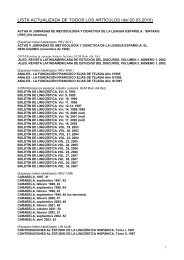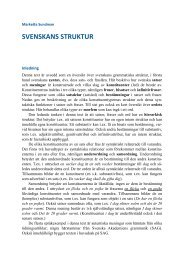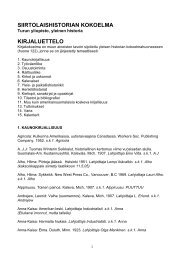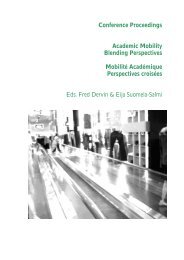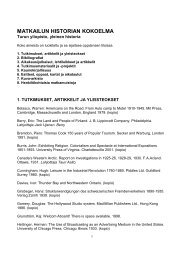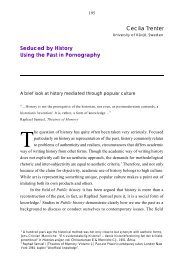Style sheet (pdf)
Style sheet (pdf)
Style sheet (pdf)
Create successful ePaper yourself
Turn your PDF publications into a flip-book with our unique Google optimized e-Paper software.
STYLE SHEET<br />
FOR PAPERS AND THESES<br />
Department of English<br />
University of Turku<br />
2013-14
1 Introduction<br />
The purpose of this style <strong>sheet</strong> is to give general instructions about the format and<br />
organisation of written assignments at the Department of English. They are based on<br />
The Chicago Manual of <strong>Style</strong> (2003), which is regularly reviewed and updated. Should<br />
you need information that is not contained within this guide, please consult the<br />
manual.<br />
The instructions are formulated for word-processing programs. Where examples<br />
of the instructions are provided, they are placed in grey-shaded boxes for easy<br />
reference.<br />
Note that the guidelines in this style <strong>sheet</strong>, in particular those concerning the<br />
form of references, are those recommended by the Department of English; other<br />
departments may require that you follow a different system.<br />
For thesis writing, the Department has another guide, which includes<br />
information on the title page, abstract page and other structural aspects of theses.<br />
This MA thesis guide is available at www.hum.utu.fi/oppiaineet/englanti/studying/.<br />
2 Format<br />
2.1 Font<br />
The font for the text must be easily legible and not too small. The recommended font<br />
for the main body of the text is 12 points. Headings should be written in a larger<br />
font.<br />
2.2 Margins<br />
Use a margin of 2.5 cm on all sides of the paper. For MA theses, because they are<br />
bound, reserve a wider left margin, maximum 4 cm.<br />
2.3 Line spacing<br />
Use 1.5 line-spacing. Never use line spacing 1 or auto spacing. (But cf. below for<br />
quotations and examples.)<br />
2.4 Paragraphing<br />
Paragraph divisions may be indicated either by leaving a blank line between<br />
paragraphs or by indenting the first line of a new paragraph. Exception: if the<br />
paragraph follows a section heading, the first line is not indented.<br />
1
3 Organisation of the Text<br />
3.1 Sections and headings<br />
The paper should be reasonably divided into sections and, if necessary, subsections.<br />
The number of levels depends on the length of the work and the complexity of the<br />
subject matter. Please give all sections and subsections a heading and indicate the<br />
hierarchical level of the section by numbers (e.g. 2, 2.1, 2.1.1, etc).<br />
3.2 BA and MA theses<br />
The sections of a BA and MA thesis should be arranged as follows:<br />
Title page<br />
Abstract (MA theses only)<br />
Table of contents<br />
Lists of figures, tables, and abbreviations<br />
Body of the text<br />
References<br />
Appendices<br />
Finnish summary (for BA theses, this should be physically separate from the rest of<br />
the text)<br />
3.3 Figures and tables<br />
If you present facts in the form of figures (i.e. graphics) or tables, they should be<br />
numbered (e.g. Table 1, Table 2, etc.) in boldface, with their title in normal font; they<br />
are referred to in the text by their numbers (e.g. “See Table 4 for details”). All figures<br />
and tables should be self-explanatory: they should be understandable<br />
independently, without referring to the text (for instance, abbreviations used in the<br />
table should be explained in the legend of the table). Figures and tables should be<br />
relevant to your argumentation: the information they present should be discussed in<br />
the text. The example below is correct:<br />
Original Word Split Word<br />
Arbeitnehmer<br />
Treibhauseffekt<br />
Treibhauseffektgase<br />
Linguistic-based Corpus-based<br />
Arbeit Nehmer<br />
Treib Haus Effekt<br />
Treib Haus Effekt Gase<br />
2<br />
Arbeitnehmer<br />
Treibhauseffekt<br />
Treibhauseffekt Gase<br />
Table 2. Examples of splitting German words by English-speaking translation students
4 Typographical Conventions<br />
4.1 Examples and foreign words<br />
Examples of data in linguistic texts should be numbered with Arabic numerals<br />
between parentheses. Examples are set apart from the main body of the text on a<br />
separate line, with a blank line before and after, and indented. Examples should be<br />
single-spaced:<br />
(1) This is an example of how examples should be arranged in your paper or<br />
thesis. Note line spacing and indentation.<br />
(2) * Examples what is ungrammatical should be marked with an asterisk.<br />
A letter, word, phrase or sentence cited as a linguistic example or as a subject of<br />
discussion must be marked by italics. Similarly, cited forms in a foreign language<br />
should be marked by italics; they should be followed, at least at the first occurrence,<br />
by a gloss in single quotation marks:<br />
Separate is one of the most frequently misspelled words in the English language.<br />
One aspect of their national character that Finns are particularly proud of is sisu,<br />
„determination and resilience‟, as displayed by the entire people during the Winter<br />
War.<br />
4.2 Terms and Highlighting<br />
At the first occurrence of a term mark it with italics or single quotation marks:<br />
This paper discusses the differences between restrictive and non-restrictive relative<br />
clauses. Restrictive relative clauses can be defined as ...<br />
Or, alternatively:<br />
This paper discusses the differences between „restrictive‟ and „non-restrictive‟<br />
relative clauses. Restrictive relative clauses can be defined as ...<br />
For highlighting or emphasis use either italics or boldface but be consistent.<br />
3
5 Quotations and References in the Text<br />
The Golden Rule: Give Credit to Whom Credit is Due.<br />
5.1 When to do it?<br />
Data: When you are analysing or discussing primary data, always indicate the<br />
source. This includes data you have collected yourself.<br />
Research: When you make use of any work by other people, you must always<br />
indicate the source of the information; this also includes personal correspondence or<br />
conversations. Within the text, this usually means the surname of the author(s), the<br />
year of publication and the page number (see Section 5.2).<br />
There are three correct ways of making use of other people‟s studies: quotation,<br />
paraphrase and summary. Anything else is plagiarism or theft, which are illegal.<br />
5.2 Quotations<br />
All references must be provided in the running text and not in footnotes or endnotes.<br />
You may quote if you need to use the exact words of the original. For instance,<br />
this may be because the material is unique and memorable or because the original<br />
statement is well-written and more compelling than a summary or paraphrase of it<br />
would be. A quotation must match the original exactly. Even errors, such as<br />
misprints, must be reproduced; to show that the error is in the original, use [sic]<br />
after the relevant point.<br />
Below, there is a sample of an original text by Schlant. Several examples in this<br />
section will draw from it:<br />
Historians, political scientists, economists, and journalists are constrained (or ought to be)<br />
by facts, and other objective criteria, whereas literature projects the play of information,<br />
exposing levels of conscience and consciousness that are part of a culture‟s unstated<br />
assumptions and frequently unacknowledged elsewhere. Because they are unconsciously<br />
held, these assumptions provide greater insight into the moral positions at work than do its<br />
explicit opinions and images, which are often censored or the expression of wishful<br />
thinking. Literature lays bare a people‟s dreams and nightmares, its hopes and<br />
apprehensions, its moral positions and its failures. It reveals even where it is silent; its<br />
blind spots and absences speak a language stripped of conscious agendas.<br />
(Schlant 1999: 3)<br />
Every change, however trivial, should be indicated. You do so by using square<br />
brackets, as in the example below:<br />
Schlant claims that “[l]iterature [...] reveals even where it is silent; its blind spots<br />
and absences speak a language stripped of conscious agendas” (1999: 3).<br />
4
As in the example above, if the quotation is unnecessarily long for your purposes,<br />
you may use ellipsis (indicated by [...] to show that you have omitted something).<br />
You need not indicate ellipsis at the beginning or end of the quotation. The ellipsis<br />
marker should not be divided at the end of a line. Remember to use square brackets<br />
[… ] with ellipsis, not parentheses (… ). Punctuation in the original either preceding<br />
or following the ellipsis is normally retained. If the original includes such<br />
punctuation, you should mention it in your reference (see Section 5.2.1).<br />
5.2.1 Information to be included<br />
Quotations within the text should be supplied with the following information: author<br />
(not editor) year of publication: page number. Other relevant information should<br />
also be clearly marked, as in the following examples.<br />
Include the original publication date of unedited reprints, such as literary editions.<br />
In the following, the original publication is 1993; the edition used is from 1995:<br />
“I sat stupid for some time, and embarrassed you by my awkwardness” (Phillips<br />
[1993] 1995: 118).<br />
Include any emphases you add to make a particular point in the quotation clear:<br />
“I sat stupid for some time, and embarrassed you by my awkwardness” (Phillips<br />
[1993] 1995: 118; emphasis added).<br />
Mention that it is your own translation if no translation is available for a work<br />
written in a language other than English:<br />
“However, in no way should interpreting be based solely upon the concept of<br />
horizontal processing” (Tommola 2006: 22; my translation).<br />
Explain if the punctuation or capitalisation may cause confusion:<br />
Why do I still keep waiting and dreaming. Hoping . . . maybe . . . someday . . .<br />
(Sender 1986: 2; punctuation as in the original).<br />
5.2.2 Punctuation and layout of quotations<br />
Quotations within the text should be given in double quotation marks with the<br />
source reference supplied:<br />
5
Hale (2008: 9) explains that we “need a theory of ethnicity grounded solidly in<br />
psychological research on human behavior”, and that relational theory is of use in<br />
that regard.<br />
Note that, unlike Finnish, the final full stop in English is always placed after the<br />
reference (except in block quotations), regardless of the scope of the reference:<br />
Accordingly, he states: “[cohesion] may be crudely defined as the way certain words<br />
or grammatical features of a sentence can connect to its predecessors (and<br />
successors) in a text” (Hoey 1991: 3).<br />
Quotations longer than three lines are known as „block quotations‟ and should be<br />
arranged in the same way as examples: set off from the main text by blank lines<br />
before and after, single-spaced, and indented, the font size should be smaller<br />
(usually 10 if you are using 12 in the main text). Quotation marks are not used with<br />
block quotations, but the source reference is supplied. The example below is<br />
formatted correctly:<br />
Goodman has expressed this very well:<br />
When the world is lost and correspondence along with it, the first thought is usually<br />
coherence. But the answer cannot lie in coherence alone; for a false or otherwise wrong<br />
version can hold together as well as a right one. Nor do we have any self-evident truths,<br />
absolute axioms, unlimited warranties, to serve as touchstones in distinguishing right<br />
from among coherent versions; other considerations must enter into that choice.<br />
(Goodman 1984: 37)<br />
This line of thinking can be found later in other writers, too...<br />
5.2.2.1 Differences between American and British English<br />
The British style of positioning punctuation in relation to the closing quotation mark<br />
consistently follows the following rule: if the punctuation mark belongs to the quoted<br />
material, it is placed within the closing quotation mark; if it belongs to the including<br />
sentence, it is placed after the quotation mark. The American style follows this rule<br />
for exclamation marks and question marks, but not for commas and full stops. Both<br />
are placed outside the quotation marks only in rare instances where confusion is<br />
likely.<br />
6
American English:<br />
“I was dismayed,” Roger confided, “by the strange exhilaration she displayed after<br />
reading „The Metamorphosis.‟”<br />
British English:<br />
“I was dismayed”, Roger confided, “by the strange exhilaration she displayed after<br />
reading „The Metamorphosis‟”.<br />
American and British English:<br />
The first line of Le Beau‟s warning to Orlando has long been regarded as reading<br />
“Good sir, I do in friendship counsel you”.<br />
5.2.3 Works with multiple authors<br />
If a work has two or three authors, all the authors‟ names must be mentioned each<br />
time a reference is made. If the work has four or more authors, use the first author‟s<br />
name and add et al. to replace the other names:<br />
“Lexical repetitions, question marks and private verbs show a steady increase<br />
throughout, whilst first- and second-person pronouns, though they first decrease,<br />
increase towards the eighteenth century” (Culpeper & Kytö 2000: 191).<br />
“no rigid generalization can be made about the division of discourse into<br />
information units” (Quirk et al. 1972: 938).<br />
(See Section 6.1.2 for how it is done in the list of references.)<br />
5.2.4 Citing a work by a corporate author<br />
Authors can also be companies, agencies and commissions. Instead of citing a<br />
person‟s name, you then reference the name of the company, agency or commission:<br />
According to the European Commission (2007: n.p.), “the countries that make<br />
up the EU [...] remain independent sovereign nations but they pool their<br />
sovereignty in order to gain a strength and world influence none of them could<br />
have on their own.”<br />
7
5.2.5 Dictionaries and Encyclopaedias<br />
Only refer to these when the entry constitutes your data or is integral to your<br />
argument. The entry is preceded by s.v. (sub verbo, „under the word‟):<br />
In the Middle English period, the word meat was often used to refer to food in<br />
general (OED Online, s.v. meat n.).<br />
5.2.6 The use of ibid.<br />
When referring to the same work repeatedly, you may use ibid. to indicate when the<br />
quotation has been taken from the same source and page as the last one mentioned.<br />
If you are referring to many different sources, this can become very confusing;<br />
however, for an extended discussion of a single source involving many brief<br />
quotations, ibid. may prove useful. The following example is correct:<br />
When Jane talks to Mr. Rochester about seeing Bertha for the first time, she is<br />
frightened and appalled by the creature she encountered (Brontë [1847] 1998: 340).<br />
She is agitated and confused by the unfamiliar “spectre” (ibid.).<br />
5.3 Paraphrases<br />
If there is no need for you to quote verbatim, „word-for-word‟, you should<br />
paraphrase, i.e. report in your own words what is said in the source. The example<br />
below is a good paraphrase of the original (see page 4 of this <strong>Style</strong> Sheet):<br />
Schlant explains that literature can tell the reader much about the nation that<br />
produced it even unintentionally, and that what is left unsaid or untouched may be<br />
as revealing as that which is discussed (Schlant 1999: 3).<br />
If you quote verbatim without using quotation marks – as if you were paraphrasing –<br />
you are in fact plagiarising, which is illegal. The following example, then, is<br />
plagiarism – even though you have given the author, year and page number:<br />
Schlant claims that literature reveals even where it is silent; its blind spots and<br />
absences speak a language stripped of conscious agendas (1999: 3).<br />
Note that the same applies even if you have translated the text yourself.<br />
If you quote or paraphrase without indicating the source, you are committing<br />
theft of intellectual property, which is a serious crime in the academic world.<br />
8
You need not give a reference for recognised facts or generally accepted ideas and<br />
opinions. For example, you should write:<br />
Factual texts and works of literature serve different functions.<br />
Although it is true that the point that factual texts and works of literature are<br />
different was explained by a certain author, it is a general fact and not a discovery or<br />
product of intellectual insight. Naturally, if the phrase above were exactly what was<br />
written, it must be quoted verbatim.<br />
In paraphrases, just as for quotations (5.2.2), the final full stop is always placed<br />
after the reference:<br />
According to Hoey, cohesion refers to features that connect a sentence to the<br />
sentences surrounding it in a text (1991: 3).<br />
If you wish to clarify that you have drawn on the same source for several lines, you<br />
need to include an overt statement to this effect within your own text:<br />
Hale (2008: 62-63) explains the importance basing one‟s theory clearly upon the<br />
assumptions one has made regarding what motivates the subjects‟ behaviour within<br />
the theory framework. He explains that with regard to the relational theory of<br />
ethnicity individual‟s behaviour can be most helpfully assumed to be that which<br />
maximises their life chances. No further level of detail is actually necessary at this<br />
stage in the current research, though he admits that it may be useful for others<br />
working in the same area in the future.<br />
5.4 Summaries<br />
In situations where you wish to describe the contents of an entire work or chapter of<br />
a work, you should summarise. You explain the subject and aim of the work (or<br />
chapter) without necessarily going into great detail. You also provide the reader with<br />
the following information: the name(s) of the author(s), the type of work (book,<br />
article, study, etc.), the name of the work, and the year of its publication. Below is an<br />
example of how one of Juliane House‟s works is summarised by Giuseppe Palumbo<br />
(2009: 161) in his book Key Terms in Translation Studies (the use of bold type for<br />
emphasis is in the original):<br />
9
One of the first systematic models of translation assessment has been elaborated by<br />
the German scholar Juliane House, whose book A Model for Translation Quality<br />
Assessment first appeared in 1977. The model underwent substantial revision,<br />
especially in its „operational‟ component, in the following years and was presented<br />
in its revised form in House (1997). House‟s model can be said to have played a<br />
pioneering role in many respects, especially as regards the recognition of contextual<br />
features and the role played by different types of equivalence.<br />
5.5 Other references within the text<br />
5.5.1 References to longer works of fiction (novels and films)<br />
When you refer to a whole book or film in your text, use the title of the work in italics<br />
and capitalise the lexical words. Note that articles may not be dropped. You may use<br />
abbreviated titles, but these should be self-explanatory (lexical words, not acronyms)<br />
and listed in the “Abbreviations” section if they are numerous. Use the full title at<br />
the first occurrence and indicate in parentheses how you will refer to the novel or<br />
film henceforth:<br />
The first line of The Color Purple (Purple) is the only one which is not included in<br />
a letter.<br />
5.5.2 References to short works<br />
The title of a short story or poem (in general, any work not published under its own<br />
cover) is capitalised and given in single quotation marks:<br />
„My Cousins Who Could Eat Cooked Turnip‟<br />
„Shall I Compare Thee to a Summer‟s Day‟<br />
Titles of long poetic works, collections, or anthologies are italicised and not enclosed<br />
in quotation marks:<br />
Robert Frost‟s poem „The Housekeeper„ in his collection A Boy’s Will<br />
Dante‟s Inferno<br />
10
When you refer to poems, use line references; if the poem is divided into sections or<br />
books, refer to [Book. Lines]. Excerpts from poems are typed with exactly the same<br />
layout, capitalisation and punctuation as in the original:<br />
What dire Offence from am'rous Causes springs,<br />
What mighty Contests rise from trivial Things, [I.1-2]<br />
Excerpts from prose works are typed similarly to excerpts from non-literary works:<br />
shorter ones in the running text with quotation marks, longer ones indented and<br />
single-spaced without quotation marks.<br />
5.5.3 References to Internet sources<br />
For sources available as Internet pages, give the surname of the author(s) and the<br />
year of publication of the material or of the most recent update. For collectively<br />
authored Internet sources, give the name of the website and the year of publication.<br />
The example following is correct:<br />
… can be divisive factors in cyberspace as well (Gurak 1995).<br />
5.5.4 References to ebooks<br />
In addition to author and the year of publication of the ebook version, references to<br />
ebooks should contain as accurate information of the source as possible. If there is<br />
no pagination, this would typically include the numbers of the book (if given) and<br />
chapter (if given) in question. The example below is from a source without<br />
pagination:<br />
… is well illustrated in this scene (James 1996, bk. 6, chap.1).<br />
5.5.5 References to plays and the Bible<br />
For plays, provide the reference in the format Act: Scene: Line. See examples below:<br />
In Twelfth Night, Shakespeare … (I.v.165-187).<br />
Chaucer shows in Troilus and Criseyde ... (III: 994).<br />
11
Biblical references should give book, chapter and verse (you need not refer to the Old<br />
or New Testament):<br />
Ecclesiastes 12: 1.<br />
5.5.6 Indirect Citations<br />
An indirect citation (sometimes referred to as a secondary source citation) is a work to<br />
which you have access only indirectly, through a citation in the source you are<br />
using. These should be avoided because they show you have not read the original<br />
work. For instance, suppose you read a text by Sue Vice in which she discusses the<br />
work of Mikhail Bakhtin. If you want to quote Bakhtin, you should get hold of the<br />
original text by him and not take the quotation from Vice. When no alternative is<br />
available or the original text is in a language you do not speak, you should provide<br />
as much information about the original text (the full name of the original author, the<br />
full title of the book or article, and the year of publication) as you possibly can in the<br />
running text. The actual reference is to the source you have used:<br />
(Bakhtin in Vice 1997: 32).<br />
6 The List of References<br />
Golden Rules for Reference Lists<br />
Be consistent<br />
Provide sufficient information for the interested reader to trace your sources<br />
Please note that the punctuation used in this department has been simplified and<br />
adapted from The Chicago Manual. The author/date references in the running text<br />
refer the reader to the full entry, given in the “References” section at the end of the<br />
work. Entries are given in alphabetical order by first author. You list your primary<br />
sources (your data or other research material) and your secondary sources (scholarly<br />
works referred to in your text) separately. Typically, the primary sources for a paper<br />
on a literary topic would consist of the novels, poems and/or plays discussed; those<br />
for a work on a linguistic topic would consist of the corpus or text(s) used. Secondary<br />
sources are the scholarly / analytical works that analyse or discuss the primary<br />
sources.<br />
The following instructions show the order in which the different items of<br />
information are presented and how the entry is punctuated. Examples of all major<br />
12
types of entry are given in the sample “References” section at the end of the <strong>Style</strong><br />
Sheet.<br />
6.1 Books<br />
A reference to a book should include the following information:<br />
a) surname first name of the author(s) or editor(s), or if the work is edited, add<br />
(ed.) or (eds):<br />
Coulthard Malcolm (ed.) 1994.<br />
b) year of publication followed by a FULL STOP. If you are using a new (revised)<br />
edition of a work, always use the date of the new edition and give the number of<br />
the edition after the title followed by a FULL STOP. If you are using a book which<br />
has been published more than once without being revised, give both the original<br />
date of publication in square brackets and the date of the version you are using<br />
followed by a FULL STOP:<br />
Austen Jane [1813] 1978.<br />
c) if you refer to more than one work published during the same year by the same<br />
author, list them in alphabetical order by title and separate them using letters<br />
after the year:<br />
Hoey 1986a, 1986b.<br />
d) title and subtitle in italics; use capital initials for content words followed by a<br />
FULL STOP. If the work consists of several volumes, give the volume number(s) and<br />
possible volume title followed by a FULL STOP. The example below is correct:<br />
Keen Suzanne 1998. Victorian Renovations of the Novel: Narrative Annexes and<br />
the Boundaries of Representation. Cambridge: Cambridge University Press.<br />
If relevant, give the series title unitalicised and the number of volume followed by<br />
a FULL STOP:<br />
Cooper Charles R. & Greenbaum Sidney (eds) 1986. Studying Writing: Linguistic<br />
Approaches. Written Communication Annual 1. Beverly Hills, CA: Sage.<br />
e) place of publication (i.e. the city or town where the head office of the publisher –<br />
not the printer – is located) followed by a COLON name of publisher followed by a<br />
FULL STOP. If two cities are listed for the publisher, you should use both. Note that<br />
13
this location may vary for the same publisher: for instance, the place of<br />
publication for a book published by Cambridge University Press is Cambridge &<br />
New York, that for Routledge is London & New York. The most reliable source of<br />
information on publication is on the copyright page. If there are more than two<br />
locations given, use the first only. Use the example below:<br />
Palumbo Giuseppe 2009. Key Terms in Translation Studies. London & New York:<br />
Continuum.<br />
6.1.1 Citing a book with one author or editor<br />
a) surname first name or initials, according to how the author is referred to on the<br />
cover.<br />
b) year of publication followed by a FULL STOP<br />
c) title and subtitle in italics; content words capitalised followed by a FULL STOP<br />
d) place of publication followed by a COLON name of publisher then a FULL STOP<br />
For an author:<br />
Hoey Michael 2001. Textual Interaction: An Introduction to Written Discourse<br />
Analysis. London: Routledge.<br />
For an editor:<br />
Coulthard Malcolm (ed.) 1994. Advances in Written Text Analysis. London:<br />
Routledge.<br />
n.b. Anonymous works are listed under the editor‟s name.<br />
6.1.2 Citing a book with two or more authors or editors<br />
a) surname first name or initials followed by a COMMA surname first name or initials<br />
& surname first name or initials<br />
b) year of publication followed by a FULL STOP<br />
c) title and subtitle in italics followed by a FULL STOP<br />
d) place of publication followed by a COLON name of publisher then a FULL STOP<br />
14
The following example lists the works correctly:<br />
Brett P. D., Johnson S. W. & Bach C. R. T. 1987. Mastering String Quartets. San<br />
Francisco: Amati Press.<br />
Quirk Randolph, Greenbaum Sidney, Leech Geoffrey & Svartvik Jan 1972. A<br />
Grammar of Contemporary English. London: Longman.<br />
Unwin Liam P. & Galloway Joseph 1990. Peace in Ireland. Boston: Stronghope<br />
Press.<br />
6.1.3 Citing a book written in a language other than English<br />
For works not written in English, the layout remains the same except that the<br />
capitalisation follows the conventions of the original language. The translation of the<br />
title should be in normal font and placed in parentheses after the original title:<br />
Gross Natan, Yaoz-Kest Itamar & Klinov Rinah (eds) 1974. Ha-Shoah be-Shirah<br />
ha-Ivrit: Mivhar (The Holocaust in Hebrew Poetry: An Anthology). Ha-Kibbutz<br />
ha-Me‟uhad.<br />
For works that are translated, the layout also remains the same except that the<br />
name of the translator is included after the title:<br />
Eliot T. S. 1996. Poesie 1905-1920. (Poetry 1905-1920) Transl. Bagicalupo<br />
Massimo. Roma: Newton.<br />
6.1.4 Citing a book with a group author (company or agency)<br />
For works with no named author(s), the organisation or agency is given as the<br />
author:<br />
a) name of organisation<br />
b) year of publication followed by a FULL STOP<br />
c) title and subtitle in italics; use capital initials for content words followed by a<br />
FULL STOP<br />
d) if relevant, number of edition<br />
e) if relevant, followed by a COMMA and volume(s) used followed by a FULL STOP<br />
f) place of publication followed by a COLON publisher followed by a FULL STOP<br />
If applicable, include the series title followed by the number as in the example below:<br />
International Monetary Fund 1977. Algeria, Mali, Morocco, and Tunisia. Surveys<br />
of African Economies 7. Washington, D.C.: International Monetary Fund.<br />
15
6.1.5 Citing a book with an editor / editors<br />
For works which are edited, the layout remains the same as for authored books<br />
except that (ed.) or (eds) appears immediately after the names of the editor(s):<br />
Cooper Charles R. & Greenbaum Sidney (eds) 1986. Studying Writing: Linguistic<br />
Approaches. Written Communication Annual 1. Beverly Hills, CA: Sage.<br />
Note that when referring to such a work within the text, the author should be cited.<br />
6.2 Articles<br />
6.2.1 Citing an article in an edited book<br />
A reference to an article in a book should include the following information:<br />
a) surname first name of the author(s)<br />
b) year of publication followed by a FULL STOP<br />
c) title of the article (do not use capital initials except for words which are always<br />
capitalised and the first word in the subtitle) followed by a FULL STOP<br />
e) then IN surname of the editor(s), followed by (ed.) or (eds) followed by a COLON<br />
f) pages where the article occurs followed by a FULL STOP<br />
g) list the book under the name of the first editor as in 6.1.5.<br />
The following example is correct:<br />
Showalter Elaine (ed.) 1985. The New Feminist Criticism. New York: Pantheon Books.<br />
Woodcock Bruce 1985. „Long memoried women‟: Caribbean women poets. In<br />
Showalter (ed.): 55-78.<br />
Note that you do not need to keep these items together in the final list of works cited.<br />
Alphabetise the list as usual.<br />
6.2.1 Citing an article in a journal<br />
A reference to an article in a journal should include the following information:<br />
a) surname first name of the author(s) of the article<br />
b) year of publication followed by a FULL STOP<br />
c) title of the article; do not use capital initials except for the first word of the main<br />
title and subtitle, and words that are always capitalised followed by a FULL STOP<br />
d) title of the journal in italics and volume number followed by a COLON<br />
e) pages where the article occurs followed by a FULL STOP<br />
Note: most academic journals use continuous pagination throughout the volume;<br />
if this is not the case, you should give the issue number after the volume<br />
number in brackets.<br />
16
The example below is correct:<br />
Hopper Paul J. & Thompson Sandra A. 1980. Transitivity in grammar and<br />
discourse. Language 56: 251-299.<br />
Moses A. Dirk 2000. An antipodean genocide? The origins of the genocidal<br />
moment in the colonization of Australia. Journal of Genocide Research 2 (1):<br />
89-106.<br />
6.3 Citing a Film<br />
a) title and subtitle in italics followed by a FULL STOP<br />
b) year of release followed by a FULL STOP<br />
c) surname first name of director (dir) or (dirs) followed by a FULL STOP<br />
d) name of film company followed by a COLON name of distributer followed by a FULL<br />
STOP<br />
The example below is correct:<br />
Cement Garden, The. 1992. Birkin Andrew (dir). Neue Constantin Film<br />
Production.<br />
Note that articles are placed after the title in order to maintain the alphabetical order<br />
in the list.<br />
6.4 Citing an electronic source<br />
6.4.1 Internet sources<br />
A reference to an internet page should include the following information:<br />
a) surname first name of the author(s) or name of the organisation<br />
b) year of publication or of the most recent update followed by a FULL STOP<br />
c) title of the document, followed by [online] followed by a FULL STOP<br />
d) title of source in italics or, if applicable, linked from title of complete work in<br />
italics. „Available‟ followed by a COLON<br />
e) full address of the website without http://.<br />
f) date of access (in parentheses) followed by a FULL STOP<br />
The example below is correct:<br />
Defense Intelligence Agency 1999. DIA: A brief history online. Available:<br />
www.dia.mil/present/dia-history_intro.html (31 January 2005).<br />
6.4.2 Citing a CD-ROM<br />
A reference to a CD-ROM should include the following information:<br />
a) Name of producer year of production followed by a FULL STOP<br />
17
) title of CD-ROM in italics (and version number where appropriate) followed by<br />
[CD-ROM] followed by a FULL STOP<br />
c) place of production followed by a COLON<br />
d) manufacturing company followed by a FULL STOP<br />
The example below is correct:<br />
Pen and Ink 1997. Amazing Facts (Version 3.1) [CD-ROM]. Chicago: Multimedia<br />
Productions, Inc.<br />
6.4.3 Citing an ebook<br />
As with CD-ROMs, ebooks should contain indication of the format. They should<br />
also indicate the publisher of the electronic version. There are original ebooks and<br />
older material that has been changed into electronic format.<br />
The examples below are correct:<br />
Original ebooks:<br />
Hellman Hall 1998 [Rocket ebook]. Great Feuds in Science: Ten of the Liveliest<br />
Disputes Ever. New York: John Wiley.<br />
Electronic editions of older works:<br />
James Henry [1903] 1996 [Project Gutenberg ebook]. The Ambassadors.<br />
Available: ftp://ibiblio.org/pub/docs/books/gutenber/etext96/ambas10.txt.<br />
6.7 Multiple Entries by the Same Person<br />
If you refer to more than one work by the same author which are published during<br />
the same year, the references should be marked with lower case letters for clarity:<br />
Hoey Michael 1986a. Overlapping patterns of discourse organization and their<br />
implications for clause relational analysis in problem-solution texts. In Cooper<br />
& Greenbaum (eds): 187-214.<br />
Hoey Michael 1986b. The discourse colony: A preliminary study of a neglected<br />
discourse type. In Coulthard (ed.): 1-26.<br />
Items should be listed in ascending chronological order (oldest first).<br />
18
7 References<br />
Primary sources<br />
Austen Jane [1813] 1978. Pride and Prejudice. Harmondsworth: Penguin.<br />
Cement Garden, The. 1992. Birkin Andrew (dir). Neue Constantin Film<br />
Production.<br />
Eliot T. S. 1996. Poesie 1905-1920. (Poetry 1905-1920) Transl. Bagicalupo<br />
Massimo. Roma: Newton.<br />
Gross Natan, Yaoz-Kest Itamar & Klinov Rinah (eds) 1974. Ha-Shoah be-Shirah<br />
ha-Ivrit: Mivhar (The Holocaust in Hebrew Poetry: An Anthology). Ha-Kibbutz<br />
ha-Me‟uhad.<br />
The Helsinki Corpus of English Texts. 1991. Helsinki: University of Helsinki.<br />
Secondary sources<br />
Brett P. D., Johnson S. W. & Bach C. R. T. 1987. Mastering String Quartets. San<br />
Francisco: Amati Press.<br />
Cooper Charles R. & Greenbaum Sidney (eds) 1986. Studying Writing: Linguistic<br />
Approaches. Written Communication Annual 1. Beverly Hills, CA: Sage.<br />
Coutlhard Malcom (ed.) 1986. Talking about Text: Studies Presented to David<br />
Brazil on his Retirement. Discourse Analysis 13. Birmingham: English<br />
Language Research.<br />
Coulthard Malcolm (ed.) 1994. Advances in Written Text Analysis. London:<br />
Routledge.<br />
Culpeper J. & Kytö M. 2000. Data in historical pragmatics: Spoken interaction<br />
(re)cast as writing. Journal of Historical Pragmatics 1: 175-199.<br />
Davenport Thomas H & Beck John C. [TK3 Reader ebook]. The Attention Economy.<br />
Understanding the New Currence of Business. Cambridge, MA: Harvard<br />
Business School Press.<br />
Defense Intelligence Agency. 1999. DIA: A brief history online. Available:<br />
www.dia.mil/ present/dia-history_intro.html (31 January 2005).<br />
European Commission 2007. How the European Union Works: Your Guide to the<br />
EU Institutions. Luxembourg: Office for Official Publications of the European<br />
Communities.<br />
Goodman Nelson 1984. Of Mind and Other Matters. Cambridge, MA: Harvard<br />
University Press.<br />
Gurak L.J. 1995. On “Bob”, “Thomas”, and other new friends: Gender in<br />
cyberspace [online]. CMC Magazine (Feb 1995). Available:<br />
www.december.com/cmc/mag/1995/feb/last.html (3 May 1998).<br />
Hale Henry E. 2008. The Foundations of Ethnic Politics: Separatism of States and<br />
Nations in Eurasia and the World. Cambridge: Cambridge University Press.<br />
19
Hoey Michael 2001. Textual Interaction: An Introduction to Written Discourse<br />
Analysis. London: Routledge.<br />
Hoey Michael 1986a. Overlapping patterns of discourse organization and their<br />
implications for clause relational analysis in problem-solution texts. In<br />
Cooper & Greenbaum (eds): 187-214.<br />
Hoey Michael 1986b. The discourse colony: A preliminary study of a neglected<br />
discourse type. In Coulthard (ed.): 1-26.<br />
Hoey Michael 1991. Patterns of Lexis in Text. Oxford: Oxford University Press.<br />
Hopper Paul J. & Thompson Sandra A. 1980. Transitivity in grammar and<br />
discourse. Language 56: 251-299.<br />
House Juliane 1977. A Model for Translation Quality Assessment. Tubingen: Narr.<br />
House Juliane 1997. Translation Quality Assessment: A Model Revisited.<br />
Tubingen: Narr.<br />
International Monetary Fund 1977. Algeria, Mali, Morocco, and Tunisia. Surveys of<br />
African Economies 7. Washington, DC: International Monetary Fund.<br />
James Henry [1903] 1996 [Project Gutenberg ebook]. The Ambassadors.<br />
Available: ftp://ibiblio.org/pub/docs/books/gutenber/etext96/ambas10.txt.<br />
Keen Suzanne 1998. Victorian Renovations of the Novel: Narrative Annexes and the<br />
Boundaries of Representation. Cambridge: Cambridge University Press.<br />
Moses A. Dirk 2000. An antipodean genocide? The origins of the genocidal<br />
moment in the colonization of Australia. Journal of Genocide Research 2 (1):<br />
89-106.<br />
OED Online [online]. Oxford University Press 2009. Available: www.oed.com (17<br />
September 2010).<br />
Palumbo Giuseppe 2009. Key Terms in Translation Studies. London & New York:<br />
Continuum.<br />
Pen and Ink 1997. Amazing Facts (Version 3.1) [CD-ROM]. Chicago: Multimedia<br />
Productions, Inc.<br />
Phillips Caryl [1993] 1995. Crossing the River. London: Vintage.<br />
Quirk Randolph, Greenbaum Sidney, Leech Geoffrey & Svartvik Jan 1972. A<br />
Grammar of Contemporary English. London: Longman.<br />
Schlant Ernestine 1999. The Language of Silence: West German Literature and the<br />
Holocaust. New York & London: Routledge<br />
Sender Ruth Minsky 1986. The Cage. New York: Macmillan.<br />
Showalter Elaine (ed.) 1985. The New Feminist Criticism. New York: Pantheon<br />
Books.<br />
Tommola Jorma (ed.) 2006. Kieli ja kulttuuri kääntäjän työvälineinä (Language and<br />
Culture as a Translator‟s Tools). Turku: Painosalama<br />
Tommola Jorma 2006. Muoto ja merkitys kääntämisessä ja tulkkauksessa (Form<br />
and Meaning in Translating and Interpreting). In Tommola, J. (ed.): 9-24.<br />
20
University of Chicago Press 2003. Chicago Manual of <strong>Style</strong>. 15th ed. Chicago:<br />
University of Chicago Press.<br />
Unwin Liam P. & Galloway Joseph 1990. Peace in Ireland. Boston: Stronghope<br />
Press.<br />
Vice S. 1997. Introducing Bakhtin. Manchester: Manchester University Press.<br />
Woodcock Bruce 1985. „Long memoried women‟: Caribbean women poets. In<br />
Showalter (ed.): 55-78.<br />
21




